Baekdamsa Temple (백담사)
0m 26525 2021-05-03
746, Baekdam-ro, Inje-gun, Gangwon-do
+82-33-462-6969
Located within Seoraksan Mountain, Baekdamsa Temple was built by Monk Ja Jang (590~658) during the reign of Queen Jindeok (647-654), 28th ruler of the Silla Kingdom. The temple was burnt down and moved several times until 1957 when it was rebuilt to the current location. There are various treasures and hermitages in the temple. Many famous people have visited the temple including Manhae Han Yong-un, a strong independence activist and poet. There are countless number of rock towers in front of the temple by the creek where visitors come to stack stones while praying for their wishes.
Baekdamgyegok Valley (백담계곡)
3.4 Km 15757 2021-06-25
150, Baekdam-ro, Inje-gun, Gangwon-do
+82-33-801-0977
Baekdamgyegok Valley stretches over an eight kilometer section from Baekdamsa Temple to Yongdae-ri in Inje-gun. The valley has a road, but it is closed to general traffic. The valley is located within Seoraksan National Park. The stream running through the valley is wide and deep. The name of the valley comes from the claim that there are one hundred ('baek' in Korea) pools ('dam') of water along the valley. Baekdamgyegok Valley features clean water and lush forests.
Baekundonggyegok Valley (백운동계곡)
3.7 Km 7960 2019-12-05
Baekdam-ro, Buk-myeon, Inje-gun, Gangwon-do
+82-33-462-2554
Baekundonggyegok Valley flows 5 km from the valley of Deoktaesan Mountain and Seongaksan Mountain. There are oak trees and maple trees growing in thick clusters and clean waters flowing nearby.
Baekundonggyegok Valley stands between the seven brother stones and Yongdampokpo Falls, and starting from this point to Gwuiddegicheong Peak is Baekundonggyegok Valley. The rocks are connected in a long line and ponds can be seen here and there. On each side of the valley there are rock walls, which make for some unforgettable scenery. Baekundonggyegok Valley maintains its natural beauty and majesty, which attracts many hikers. Especially from the middle point where Jikbaekun and Gokbaekun combine to make the Gugokgyegok Valley the most magnificent scenery of Baekundonggyegok Valley can be seen. The largest waterfall of Baekundonggyegok Valley, called Baekunpokpo Falls, is about 30 meters high. The upper part of the waterfall has rocks lined up in a long line. The landscape of Seoraksan Mountain seen from this point is the representative landscape of the mountain.
Baekdam Soft Bean Curd (백담순두부)
4.4 Km 16327 2024-03-15
19 Baekdam-ro, Buk-myeon, Inje-gun, Gangwon-do
This restaurant is a showcase for Inje’s celebrated culinary offering: Grilled Dried Pollack. The pollack is prepared through a natural drying process in the brisk winter winds, which gives it a salty flavor and a satisfying chewy texture. This makes it a popular choice as both an accompaniment to drinks and as a side dish on Korean dining tables. Here, it is grilled to perfection with a coating of red pepper paste, offering a flavorful experience with a reduced fishy smell and a delightful sweet and tangy taste. Also featured on the menu are the Soft Bean Curd Set Menu and the Wild Vegetable Bibimbap. The soft and warm bean curd, along with bibimbap—a harmonious mix of freshly-grown wild vegetables from Gangwon State topped with spicy red pepper paste—each provide a nutritious wholesome meal.
Manhae Village (만해마을)
5.7 Km 28971 2021-07-29
91, Manhae-ro, Inje-gun, Gangwon-do
+82-33-462-2303
Manhae Village was established as a training center and memorial hall for national activist Monk Manhae Han Yongun, revered for his literary and philosophical inspiration, as well as his devotion to the nation and Korean people during the Democracy Movement.
Jangsudae Pavilion (장수대)
5.8 Km 8983 2020-03-24
4193, Seorak-ro, Inje-gun, Gangwon-do
+82-33-463-3476
Jangsudae Pavilion was completed on October 1, 1959 to commemorate the great victory of the battle held at Seoraksan Mountain during the Korean War. It serves as a resting spot for visitors who hike up the park to visit attractions nearby such as the Daeseung Falls, Oknyeotang Spring, Gamatang Spring, Hangyesanseong Fortress, and Haneulbyeok Wall. The pavilion is built in a traditional Korean style and considered as an excellent hermitage in terms of both structure and size. The surrounding nature consisting of mountain cliffs and pine forest makes the building stand out even more.
Seorak Special Tourist Zone (설악 관광특구)
6.0 Km 7795 2020-03-25
Sokcho-si, Gangwon-do
+82-33-249-2775
Seorak Special Tourist Zone is a vast zone included in 3 administrative districts, encompassing the entirety of Seoraksan Mountain. In this zone, visitors have various ways to enjoy Seoraksan Mountain and the natural environment of the East Sea region.
Sokcho, which occupies the largest area in the zone, comes first when talking about Seoraksan National Park. Tourists can appreciate the picturesque scenery of the sea and coastal lakes as well as the mountain scenery of Seoraksan Mountain. Hikers can climb the mountain or ride a cable car. Sokcho Beach is a hot spot that attracts young people who fill the place with energy and life all through the summer.
Abai Village, which appeared in several TV dramas for its unique atmosphere, and Sokcho Jungang Market offer local specialties, such as abai sundae (Korean sausage) and dak gangjeong (glazed fried chicken bites).
Goseong, which is bordered by Seoraksan Mountain and Geumgangsan Mountain, is part of the Northern Limit Line (NLL) that offers a unpolluted, beautiful landscape around the Demilitarized Zone (DMZ). Hwajinpo Beach near Hwajinpo Lake, which is a lagoon, and Songjiho Beach near Songjiho Lake are the best places to spend a peaceful vacation. At Hwajinpo Lake, tourists can visit the summer house used by the first South Korean President Syngman Rhee and Castle of Hwajinpo, visited by the former North Korean leader Kim Il-sung before the division of the Korean Peninsula. Lastly, although it is a relatively small part of Seorak Special Tourist Zone, Yangyang has resources for mountain tourism and maritime culture, such as Seoraksan National Park and Naksan Provincial Park. Naksan Beach, Naksansa Temple and Hajodae are popular tourist sites. It is also famous as a district producing high quality pine mushroom.
* Current State of Seorak Special Tourist Zone
1) Districts Covered: Areas around Sokcho-si and parts of Goseong and Yangyang-gun, Gangwon-do
2) Area: 138.2k㎡(Sokcho 104.9k㎡, Goseong 30.5k㎡, Yangyang 2.8k㎡)
* Tourist Attractions
Seoraksan National Park, Sokcho Beach, Naksan Provincial Park, Hwajinpo Lake, Songjiho Lake, Hajodae Pavilion, Naksansa Temple, Osaek Mineral Spring, etc.
Postponed: Yongdaeri Hwangtae Festival (용대리 황태축제)
6.2 Km 17883 2022-05-16
Yongdae 3-ri Intersection, Inje-gun, Gangwon-do
• 1330 Travel Hotline: +82-2-1330 (Korean, English, Japanese, Chinese) • For more info: +82-33-462-4805
Yongdaeri Hwangtae Festival aims to promote the city as the best place for hwangtae (pollack) and to inform people about the quality and nutritional value of pollack in order to boost the region's economy. An array of hands-on pollack-themed programs are available for visitors to take part in.
Seoraksan National Park (Southern Section) (설악산국립공원 (남설악))
6.7 Km 44279 2024-04-02
801 Seorak-ro, Yangyang-gun, Gangwon-do
Seoraksan Mountain, the highest amid the Taebaek Mountain Range, boasts beautiful landscape and scenery all year round. To the east of Hangyeryeong and Misiryeong Passes is classified as the outer section ("Oeseorak"), to the west is the inner section ("Naeseorak"); and to the south of Hangyeryeong Pass as the southern section ("Namseorak").
The southern section is famous for its mineral water, hot springs, and waterfalls including Yongsopokpo, Sibipokpo, and Yeosinpokpo Falls. Jeongbongsan Mountain (1,424.2 meters) is also included in the area. There are also several different hiking courses varying in distance and duration.
Sibiseonnyeotang (Tangsudonggyegok Valley) (십이선녀탕(탕수동계곡))
6.8 Km 9456 2021-02-24
Sibiseonnyeotang-gil, Inje-gun, Gangwon-do
+82-33-462-2554
Sibiseonnyeotang Valley (Valley of the Twelve Angels’ Bath) is a beautiful valley filled with water flowing through a cascade of waterfalls and pools. In the past, there were 12 of each, although the size and shape has changed over time. The valley also features many uniquely shaped rocks and a forest comprised of many types of trees, including maple, pine nut, and pine trees. The path passing through the V-shaped valley crosses the stream often, so visiting after heavy rainfall is not recommended.
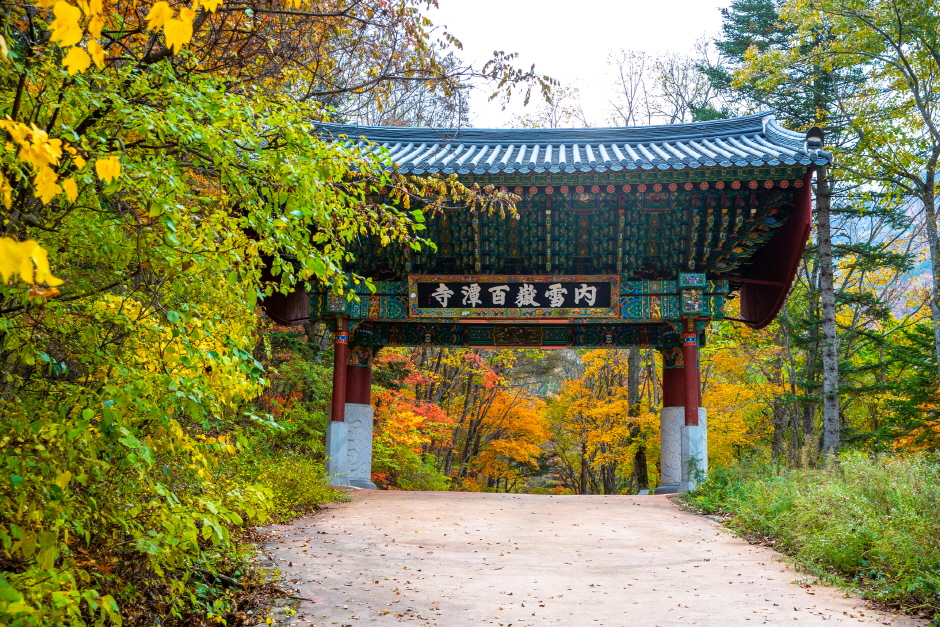
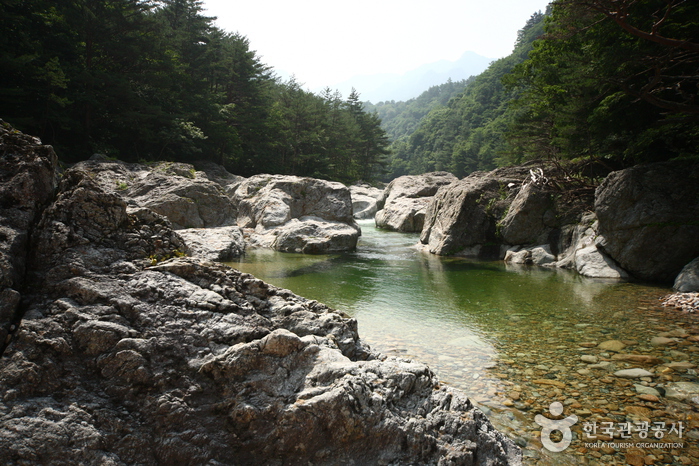

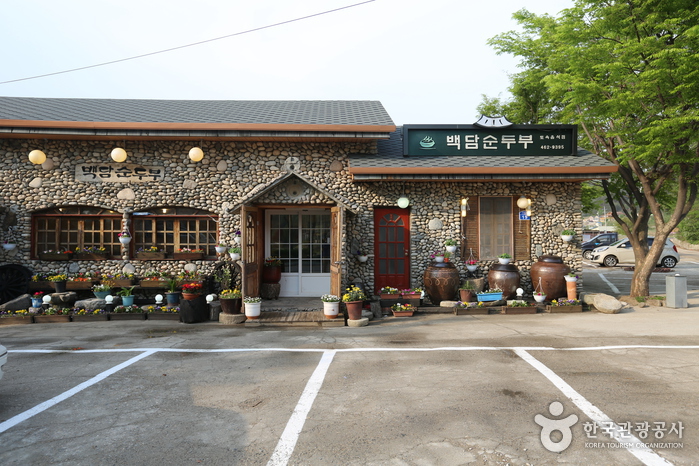
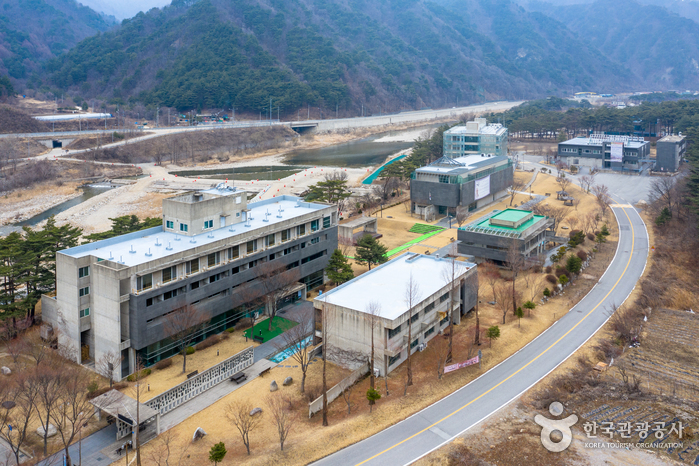
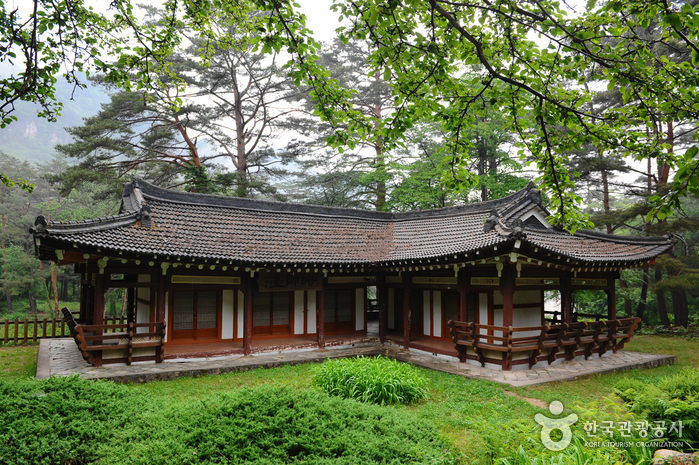
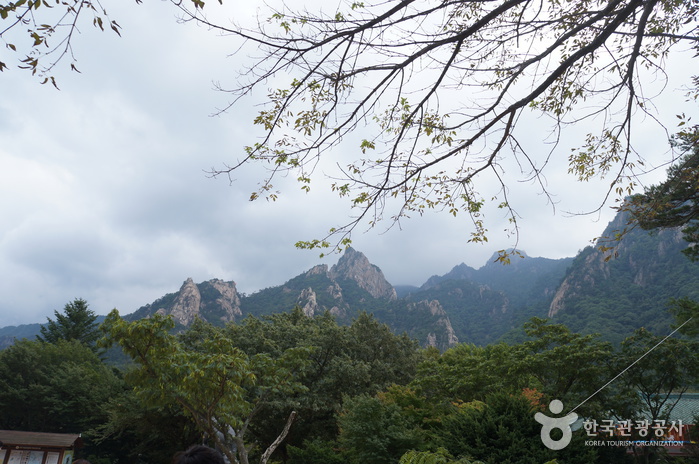
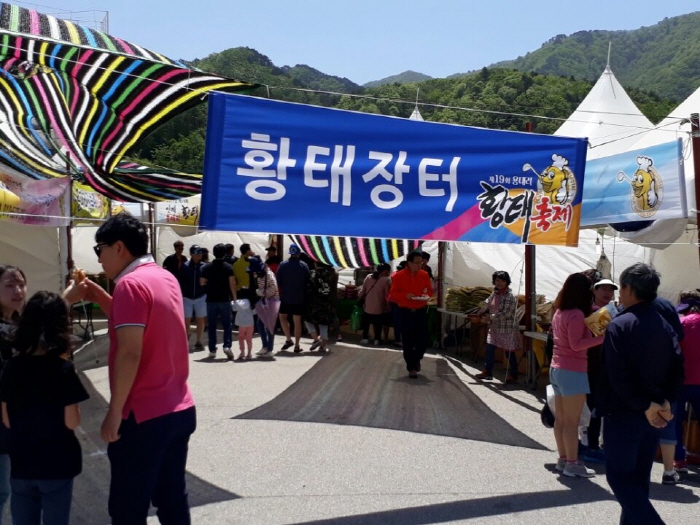
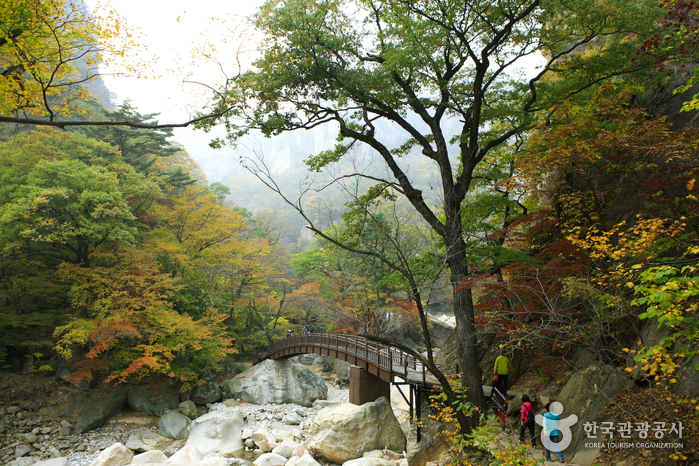
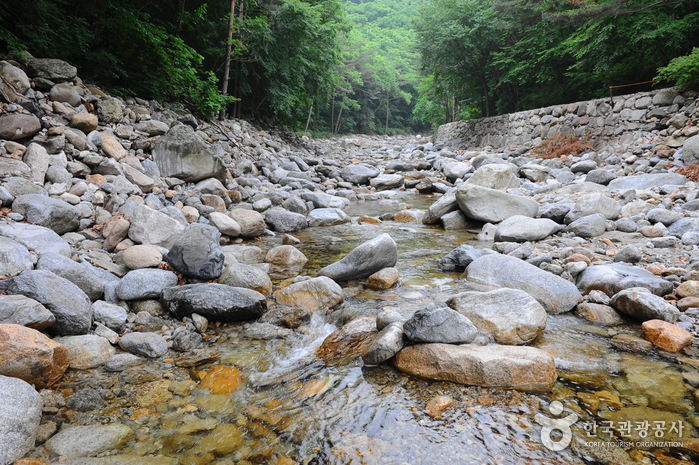
 English
English
 한국어
한국어 日本語
日本語 中文(简体)
中文(简体) Deutsch
Deutsch Français
Français Español
Español Русский
Русский